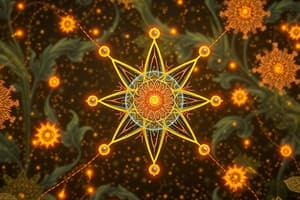Podcast
Questions and Answers
What is the effect of increasing nuclear charge on the atomic radius?
What is the effect of increasing nuclear charge on the atomic radius?
- It increases the atomic radius
- It has no effect on the atomic radius
- It decreases the atomic radius (correct)
- It causes the atomic radius to remain constant
What is the trend of ionization energy as you go from top to bottom in a group?
What is the trend of ionization energy as you go from top to bottom in a group?
- It decreases (correct)
- It increases
- It remains constant
- It first increases then decreases
What is the general trend of electron affinity as you go from left to right across a period?
What is the general trend of electron affinity as you go from left to right across a period?
- It first increases then decreases
- It increases (correct)
- It remains constant
- It decreases
What is the relationship between atomic radius and metallic character?
What is the relationship between atomic radius and metallic character?
What is the energy change associated with the addition of an electron to a gaseous atom?
What is the energy change associated with the addition of an electron to a gaseous atom?
Which of the following is true about the trend of ionization energy across a period?
Which of the following is true about the trend of ionization energy across a period?
What is the general trend of electron affinity as you go down a group?
What is the general trend of electron affinity as you go down a group?
Who formulated the first theories on chemical bonding in 1916?
Who formulated the first theories on chemical bonding in 1916?
What is the most stable arrangement of electrons in the outer shell of noble gases?
What is the most stable arrangement of electrons in the outer shell of noble gases?
What is the trend of metallic character as you go from top to bottom in a group?
What is the trend of metallic character as you go from top to bottom in a group?
Flashcards are hidden until you start studying
Study Notes
Electronic Configuration and Quantum Numbers
- Quantum numbers describe the movement of each electron within an atom.
- Four principal quantum numbers are used to specify the energy, size, shape, and orientation of an electron orbital.
- These quantum numbers describe the size, shape, and orientation in space of the orbital on an atom.
- The four principal quantum numbers are: Principal Quantum Number (n), Azimuthal/Angular Quantum Number (l), Magnetic Quantum Number (m), and Spin Quantum Number (ms).
- Each electron in an atom has a unique set of quantum numbers according to the Pauli Exclusion Principle.
The Periodic Table
- Organization of elements was developed by J.W.Döbereiner, who observed that elements could be classified into groups of three, or triads.
- Triads showed a trend where the value of the middle element would be exactly or near exactly predicted by taking the arithmetic mean of values for atomic weight and density of the other two elements.
- All three elements in a triad showed very similar chemical properties and an orderly trend in physical properties.
Newlands and Mendeleev
- J.A.R.Newlands suggested that the 62 known elements can be arranged into groups of seven according to increasing atomic mass, known as the Law of Octaves.
- Dmitri Mendeleev proposed that the properties of chemical elements repeat at regular intervals when arranged in order of increasing atomic mass.
- Mendeleev is regarded as the architect of the modern periodic table and predicted the existence and properties of three elements before their discovery.
Moseley
- H.G.J.Moseley discovered that the nuclear charge increases by 1 for each element in the periodic table by bombarding atomic nuclei with high-energy radiation.
- He concluded that arranging elements according to increasing nuclear charge (atomic number) rather than atomic mass more clearly explains their repeating properties.
The Periodic Law
- The Periodic Law states that the properties of elements recur in a repeating pattern when arranged according to increasing atomic number.
Classification of Elements by Groups and Periods
- A vertical column on the periodic table is a group or family of elements, resulting in increasing nuclear charge.
- Atomic radius decreases across the period due to the increased nuclear charge pulling electrons closer to the nucleus.
Ionization Energy
- Ionization energy is the amount of energy required to remove an electron in the gaseous state.
- Ionization energy increases as you go from the bottom to the top in a group and from left to right across a period of elements.
Electron Affinity
- Electron affinity is the energy change associated with the addition of an electron to a gaseous atom.
- Electron affinity increases generally across the period, from left to right, but decreases down a group.
Atomic Radius and Metallic Character
- Metallic character is the degree of metal character of an element.
- Metallic character decreases left to right across a period and from bottom to top in a group, similar to the trend for atomic radius.
Studying That Suits You
Use AI to generate personalized quizzes and flashcards to suit your learning preferences.




